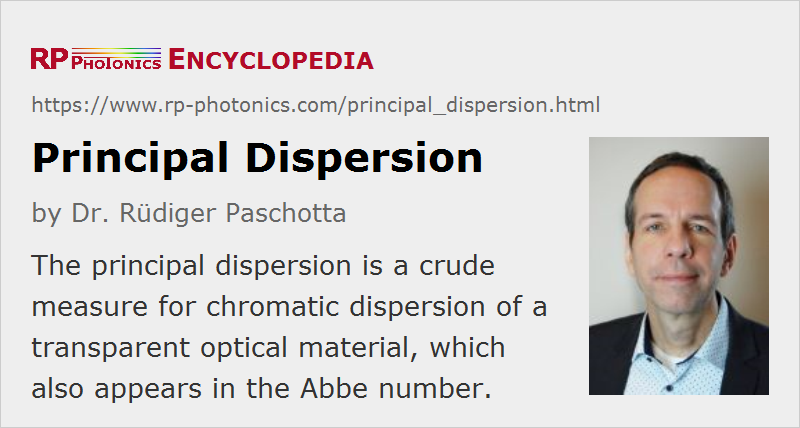Principal Dispersion
Definition: a crude measure for chromatic dispersion of a transparent optical material
German: Hauptdispersion
Author: Dr. Rüdiger Paschotta
Cite the article using its DOI: https://doi.org/10.61835/u26
Get citation code: Endnote (RIS) BibTex plain textHTML
The principal dispersion is a rather crude measure for chromatic dispersion of an optical material in the visible spectral region, which was developed in the early years of optics. It is simply the difference of refractive indices between two specific standard spectral lines of hydrogen:
- the F line at 486.1 nm (blue)
- the C line at 656.3 nm (red)
The principal dispersion <$n_\textrm{F} - n_\textrm{C}$> appears in the definition of the Abbe number.
In photographic optics, the principal dispersion is often based on two somewhat different spectral lines of cadmium:
- the F' line at 480 nm (blue)
- the C' line at 643.8 nm (blue)
More to Learn
Encyclopedia articles:
Questions and Comments from Users
Here you can submit questions and comments. As far as they get accepted by the author, they will appear above this paragraph together with the author’s answer. The author will decide on acceptance based on certain criteria. Essentially, the issue must be of sufficiently broad interest.
Please do not enter personal data here; we would otherwise delete it soon. (See also our privacy declaration.) If you wish to receive personal feedback or consultancy from the author, please contact him, e.g. via e-mail.
By submitting the information, you give your consent to the potential publication of your inputs on our website according to our rules. (If you later retract your consent, we will delete those inputs.) As your inputs are first reviewed by the author, they may be published with some delay.

 general optics
general optics
Share this with your friends and colleagues, e.g. via social media:
These sharing buttons are implemented in a privacy-friendly way!